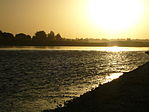Qal'eh ye-Bost
|
Lashkargah لښکرګاه |
||||||
|---|---|---|---|---|---|---|
| City | ||||||
From top left to right: Sunset over the Helmand River; Lashkargah Mosque; Lashkargah streets; Mirwais Nika Park.
|
||||||
| Location in Afghanistan | ||||||
| Coordinates: 31°34′59″N 64°22′9″E / 31.58306°N 64.36917°ECoordinates: 31°34′59″N 64°22′9″E / 31.58306°N 64.36917°E | ||||||
| Country |
|
|||||
| Province | Helmand Province | |||||
| Government | ||||||
| • Mayor | Matiullah Baheer | |||||
| Elevation | 773 m (2,536 ft) | |||||
| Population (2006) | ||||||
| • City | 201,546 | |||||
| • Urban | 276,831 | |||||
| Time zone | UTC+4:30 | |||||
| Website | www |
|||||
Lashkargah (Persian: لشکرگاه, Pashto: لښکرګاه), historically also called Bost (Persian: بُسْت), is a city in southern Afghanistan and the capital of Helmand Province. It is located in Lashkargah district, and situated between the Helmand and Arghandab rivers. The city has a population of 201,546 as of 2006. Lashkargah is linked by major roads with Kandahar to the east, Zaranj to the west, and Herat to the north-west. It is mostly very arid and desolate. However, farming does exist around the Helmand and Arghandab rivers. Bost Airport is located on the east bank of the Helmand River, five miles north of the junction of the Helmand and Argahandab rivers.
Lashkargah means "army barracks" in Persian language. The area was part of the Saffarids in the 9th century. It grew up a thousand years ago as a riverside barracks town for soldiers accompanying the Ghaznavid nobility to their grand winter capital of Bost. The ruins of the Ghaznavid mansions still stand along the Helmand River; the city of Bost and its outlying communities were sacked in successive centuries by the Ghorids, Mongols, and Timurids. However, the region was later rebuilt by Timur (Timur Lang).
By the late 16th century the city and region was governed by the Safavid dynasty. It became part of the Afghan Hotaki Empire in 1709. It was invaded by the Afsharid forces in 1738 on their way to Kandahar. By 1747 it became part of the Durrani Empire or modern Afghanistan. The British arrived in or about 1840 during the First Anglo-Afghan War but left about year later. The city was used by Ayub Khan in the Second Anglo-Afghan War until 1880 when the British helped return it to Abdur Rahman Khan. It remained peaceful for the next 100 years.
...
Wikipedia





